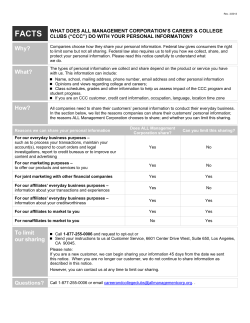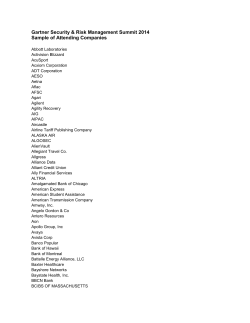
Principles of Service Oriented Architecture Mark Bailey Senior System Consultant
Principles of Service Oriented Architecture Mark Bailey Senior System Consultant Security, Government, & Infrastructure mark.bailey@intergraph.com © 2008 Intergraph Corporation Agenda Motivation for Service Oriented Architecture (SOA) SOA Defined SOA Principles Applying SOA © 2008, Intergraph Corporation Page 2 Current Environment © 2008, Intergraph Corporation Page 3 Application Centric © 2008, Intergraph Corporation Page 4 Application Centric Business scope Narrow Consumers Limited Business Processes Finance Application Application Integration Supply Application Architecture bound to EAI vendor Redundancy Manufacturing Distribution Overlapped resources Overlapped providers Business functionality is duplicated in each application that requires it. EAI ‘leverage’ application silos with the drawback of data and function redundancy. © 2008, Intergraph Corporation Page 5 Goal - Service Centric © 2008, Intergraph Corporation Page 6 Service Centric Business scope Multiple Service Consumers Multiple Business Processes Finance Service Service Supply Service Architecture Shared Service Services Service Manufacturing Distribution Multiple Discrete Resources Multiple Service Providers SOA structures the business and its systems as a set of capabilities that are offered as Services, organized into a Service Architecture Service virtualizes how that capability is performed, and where and by whom the resources are provided, enabling multiple providers and consumers to participate together in shared business activities. © 2008, Intergraph Corporation source:TietoEnator AB, Kurts Bilder Page 7 Before SOA – After SOA © 2008, Intergraph Corporation source:IBM Page 8 Why SOA? To enable Flexible, Federated Business Processes Enabling a virtual federation of participants to collaborate in an end-to-end business process Enabling alternative implementations Enabling reuse of Services Service Identification Service Ticket Collection Service Ordering Ticket Sales Service Service Service Inventory Logistics Service Service Service Service Availability Manufacturing Enabling virtualization of business resources Enabling aggregation from multiple providers source:TietoEnator AB, Kurts Bilder © 2008, Intergraph Corporation Page 9 Why SOA? To enable Business Process Optimization and the Real Time Enterprise (RTE) BPM Expressed in terms of Services Provided/Consumed Seamless End to End Process Service to Customers Enterprise Service from Multiple Suppliers Smart Clients Stores POS Mobile 3rd Party Agents Portal Internal Systems SOA Patterns: Single, Multi-Channel Service for consistency source:TietoEnator AB, Kurts Bilder © 2008, Intergraph Corporation SOA Pattern: Standardized Service provided by multiple suppliers Page 10 Why SOA? Enable Structural Improvement Process Z ERP X Standardizing capabilities e.g. Single Customer Details Service Reducing impact of change ERP Z Partner A Information Consistency Policy Consistency Service Consolidation/ Selection process CRM System 2 Process Y Encapsulating implementation complexity CRM System 1 Product System e.g. Multiple Sources of Customer Details Policy Rationalization and Evolution Resource Virtualization © 2008, Intergraph Corporation Page 11 SOA Defined SOA is a software architecture model – in which business functionality are logically grouped and encapsulated into • self contained, • distinct and reusable units called services that • represent a high level business concept • can be distributed over a network • can be reused to create new business applications • contain contract with specification of the purpose, functionality, interfaces (coarse grained), constraints, usage ... of the business functionality Services are autonomous, discrete and reusable units of business functionality exposing its capabilities in a form of contracts. Services can be independently evolved, moved, scaled even in runtime. © 2008, Intergraph Corporation Page 12 What is Service Architecture? • A collection of services • classified into types • arranged into layers • Governed by architectural patterns and policies services type © 2008, Intergraph Corporation type type source:TietoEnator AB, Kurts Bilder Page 13 Big (outer) vs. Little (inner) SOA © 2008, Intergraph Corporation Page 14 SOA is an evolutionary step for architecture © 2008, Intergraph Corporation Page 15 SOA is an evolutionary step in reusability and communication © 2008, Intergraph Corporation Page 16 SOA is an evolutionary step in distributed communications EAI Project-ware © 2008, Intergraph Corporation SOA source:Sam Gentile Page 17 Service Architecture Organized by Layers Example Layers Reasons for Layering Presentation & workflow 1. Flexible composition. 2. Reuse. 3. Functional standardization in lower levels 4. Customization in higher layers 5. Separation of Concerns. 6. Policies may vary by Layer Composed Services Basic Services Underlying API © 2008, Intergraph Corporation according to:TietoEnator AB, Kurts Bilder Page 18 Major service types Basic Services: – Data-centric and logic-centric services – Encapsulate data behavior and data model and ensures data consistency (only on one backend). – Basic services are stateless services with high degree of reusability. – Represent fundamental SOA maturity level and usually are build on top existing legacy API (underlying services) Composed Services : – expose harmonized access to inconsistent basic services technology (gateways, adapters, façades, and functionality-adding services). – Encapsulate business specific workflows or orchestrated services. © 2008, Intergraph Corporation Page 19 Service Types SOA Management & Security service mediation, routing, trust enablement. ESB, Service Registry Business centric services, orchestrated workflows. Intermediate services (gateways, facades ) Data centric and logic centric consistent services. Highly reusable, stateless servers Foundation Service Blocks Core APIs rra Te re a Sh Business Capabilities I/.. G/T e ch eo G dia e M I/CAD tC t Co Se mp r v o si ice te s Po r ta l ar m S n lie B Se as rv i c i ce s In S fra er st vi c ru e ct ur e Multi channel applications: Mobile, Smart, Thin, Thick clients, Portals. © 2008, Intergraph Corporation In r Serv the i Page 20 SOA Principles Standardized Service Contracts Loose Coupling Abstraction Reusability Autonomy Statelessness Discoverability Composability © 2008, Intergraph Corporation Page 21 Standardized Service Contracts “Services within the same service inventory are in compliance with the same contract design standards." Services use service contract to – Express their purpose – Express their capabilities Use formal, standardized service contracts Focus on the areas of – Functional expression – Data representation – Policy Source: Thomas Erl © 2008, Intergraph Corporation Page 22 Loose Coupling “Service contracts impose low consumer coupling requirements and are themselves decoupled from their surrounding environment." Create specific types of relationships within and outside of service boundaries with a constant emphasis on reducing (“loosening”) dependencies between – Service contract – Service implementation – Service consumers Source: Thomas Erl © 2008, Intergraph Corporation Page 23 Abstraction “Service contracts only contain essential information and information about services is limited to what is published in service contracts” Avoid the proliferation of unnecessary service information, meta-data. Hide as much of the underlying details of a service as possible. – Enables and preserves the loosely coupled relationships – Plays a significant role in the positioning and design of service compositions Source: Thomas Erl © 2008, Intergraph Corporation Page 24 Reusability “Services contain and express agnostic logic and can be positioned as reusable enterprise resources." Reusable services have the following characteristics: – Defined by an agnostic functional context – Logic is highly generic – Has a generic and extensible contract – Can be accessed concurrently Source: Thomas Erl © 2008, Intergraph Corporation Page 25 Autonomy "Services exercise a high level of control over their underlying runtime execution environment." Represents the ability of a service to carry out its logic independently of outside influences To achieve this, services must be more isolated Primary benefits – Increased reliability – Behavioral predictability Source: Thomas Erl © 2008, Intergraph Corporation Page 26 Statelessness "Services minimize resource consumption by deferring the management of state information when necessary." Incorporate state management deferral extensions within a service design Goals – Increase service scalability – Support design of agnostic logic and improve service reuse Source: Thomas Erl © 2008, Intergraph Corporation Page 27 Discoverability "Services are supplemented with communicative meta data by which they can be effectively discovered and interpreted." Service contracts contain appropriate meta data for discovery which also communicates purpose and capabilities to humans Store meta data in a service registry or profile documents Source: Thomas Erl © 2008, Intergraph Corporation Page 28 Composability "Services are effective composition participants, regardless of the size and complexity of the composition." Ensures services are able to participate in multiple compositions to solve multiple larger problems Related to Reusability principle Service execution should efficient in that individual processing should be highly tuned Flexible service contracts to allow different types of data exchange requirements for similar functions Source: Thomas Erl © 2008, Intergraph Corporation Page 29 Applying SOA - Governance Governance is a program that makes sure people do what is ‘right’ In conjunction with software, governance controls the development and operation of software Goal: Establish SOA organization governance (SOA Board) that governs SOA efforts and breaks down capabilities into non-overlapping services © 2008, Intergraph Corporation Page 30 Applying SOA - Governance Policies – Codification of laws, regulations, corporate guidelines and best practices – Must address all stages of the service lifecycle (technology selection, design, development practices, configuration management, release management, runtime management, etc.) Processes – Enforce policies – System-driven processes (code check-in, code builds, unit tests) – Human-driven process (requests, design reviews, code reviews, threat assessment, test case review, release engineering, service registration, etc.) Metrics – Measurements of service reuse, compliancy with policy, etc. – Organization – Governance program should be run by SOA Board, which should have crossfunctional representatives © 2008, Intergraph Corporation Page 31 Foundation Service Blocks Applying SOA – Governance Core APIs Business Capabilities te c hn ic al vi ew I/.. In r Serv ice Othe G/T e ch I/CAD eo G dia e M rra Te re a Sh Software and IT Architects r s Service Designers w Service implementation and deployment model Enterprise Architects Service specification model y lic ds Po a r d s an St d e l Mo s tern Pa t in s Bu s es se e vi c vi e SOA Board Business service model © 2008, Intergraph Corporation Page 32 Applying SOA - Challenges Service Orientation Reuse Sharing of Responsibilities Increased complexity! Business functionality has to be made available as services. Service contracts must be fixed Implemented services must be designed with reuse in mind. This creates some overhead. Potential service users must be involved in the design process and will have influence on the service design © 2008, Intergraph Corporation Page 33 Applying SOA – Renovation Roadmap (Source: Enterprise SOA: Service Oriented Architecture Best Practices by Dirk Krafzig, Karl Banke, and Dirk Slama, Prentice Hall 2004) © 2008, Intergraph Corporation Page 34 Conclusion and Summary If done correct, SOA is “not just another architectural fad” SOA seeks to bridge the gap between business and technology promoting business agility (its all about managing change) SOA – Is complex – Requires governance – Requires executive management buy-in – Requires commitment with resources (people and $$) © 2008, Intergraph Corporation Page 35 Principles of Service Oriented Architecture Mark Bailey Senior System Consultant Security, Government, & Infrastructure mark.bailey@intergraph.com © 2008 Intergraph Corporation
© Copyright 2025










